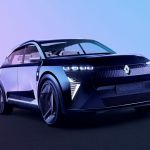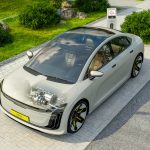Renault Group and Vitesco Technologies, a leading manufacturer of modern drive technologies and electrification solutions, are partnering for the joint development and production of power electronics in a so-called One Box for electric and hybrid powertrains—a concept they say is unique in the market.
The goal is a key electronics unit that combines the DC-DC converter, the onboard charger, and the inverter in one housing. The DC-DC converter converts the high-voltage DC (direct current) from the battery to supply the car’s low-voltage DC 14-V network. The onboard charger allows the recharging of the high-voltage DC traction battery from the electrical network. The inverter drives the electric motor in AC (alternating current) from the DC voltage of the traction battery—and controls motor speed, traction, and energy recovery during braking.
The One Box concept will enable an unprecedented gain in compactness (around 45% in terms of volume) and mass for the development of Renault’s future vehicles, particularly for passenger space and comfort. The configurations and assembly will be adapted to the types of electric and hybrid powertrains.
Development platform teams will be mostly based in Toulouse, France. The One Box is planned for electric and hybrid vehicles in Renault’s high-voltage core range from 2026 onwards, with the objective for Renault Group to eventually assemble this product in its industrial sites in France for 100% electric vehicles. The partnership will enable Renault Group to extend its control over the electrical value chain by integrating a unique power electronics all-in-one system co-developed in-house.
“Together, we will design and develop a state-of-the-art ‘One Box,’ unique on the market, which will be a real competitive advantage,” said Gilles Le Borgne, EVP Engineering, Renault Group. “With this strategic partnership, we are also further strengthening our mastery of the electric value chain and reaffirming once again our determination to anchor our technological and industrial developments for the electric vehicle in France.”
As part of this partnership, Renault Group will provide Vitesco Technologies with a multi-year contract for the power electronics of Renault’s hybrid vehicles. In addition, Vitesco Technologies will supply Renault Group with a high-voltage box, which combines the DC-DC converter and charger, for battery electric vehicles as of 2025.
“With this step, we will not only become a key ally of Renault Group on power electronics, but it is also an important milestone to further strengthen our growth in the field of electrification,” added Andreas Wolf, CEO of Vitesco Technologies.
Another example of that strengthening electrification growth was announced in May for the company’s €2 billion contract to supply its new generation axle drive EMR4 (electronics motor reducer) to Hyundai Motor Group. The highly integrated 400-V, 160-kW 3-in-1 unit will be used by the OEM in its global B/C-segment electric vehicle.
The growth in Vitesco Technologies’ electrification portfolio was on display at the 35th International Electric Vehicle Symposium (EVS) in Oslo last month. The company showed for the first time a drive solution optimized for the higher ranges of future electric cars. The EESM (externally excited synchronous electric machine) does not require the use of rare earth metals and is specifically designed for high ranges and faster highway driving for long-distance electric vehicles.
Permanently excited synchronous machines (PSMs) are common in current EVs due to the high efficiency in city traffic and medium-speed ranges of these electric motors using permanent magnets based on rare earths. However, Vitesco said that the demand for electric drives is changing. The ranges of BEVs are becoming longer, and on real long-distance routes with fast highway driving, EESMs have advantages; they are more efficient than PSMs, especially at high speeds.
Instead of magnets, the EESM rotor has coils. In addition to efficiency at high speeds, the technology offers the advantage of avoiding the costs for permanent magnets—now at a 10-year high. The CO2 footprint of the alternative drive is reduced by the portion attributable to rare earth mining, which can have a positive impact on product sustainability over its life cycle.
Vitesco Technologies is preparing a portfolio expansion that will make EESM technology available in its successful axle drives including power electronics. The company believes its many years of field experience with the technology gives it a head start in development and industrialization.
“With our portfolio, we are clearly focusing on global, scalable platforms for electrified vehicles,” said Thomas Stierle, member of the Executive Board and head of the Electrification Technology and Electronic Controls business at Vitesco Technologies. “This is where we see the growth, and this is also where the potential for sustainable and increasingly CO2-neutral mobility of the future lies.”
- The Renault/Vitesco One Box could find its way into future vehicles like the Scénic Vision concept.
- Gilles Le Borgne, Renault Group (left) and Andreas Wolf, Vitesco Technologies, sign a strategic partnership. (Yves Forestier)
- The EMR4 is Vitesco technologies fourth-generation axle drive.
- The EMR4 is Vitesco technologies fourth-generation axle drive.































































































